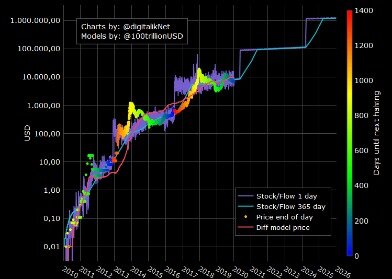Content
The reason for Bitcoin price increases is the principle of supply and demand. If the supply suddenly drops but demand stays the same, the price will inevitably rise. However, the price of Bitcoin also saw declines during the first two halvings. The halving, in July 2016, saw the price of BTC decline from $1,100 to $600 and similar in 2012. It happened as the 630,000th block was mined, triggering a 50 per cent reduction in the reward miners receive. Finally, we cannot ignore the impact of Covid-19 and the massive effect it has had on financial markets.
However, it is important to remember that given the unprecedented global crisis, these are merely speculations. Without this, institutional investors and their deep pockets remain largely on the sidelines, which means crypto remains thinly traded and therefore volatile. While there has been some progress in this area since 2017, there is still no robust regulatory framework with the international recognition that would be required to legislate for the trading and settlement of crypto assets. Miners will need to operate as efficiently as possible and there will therefore be a demand for new equipment that can deliver more hashes per second, while consuming less energy and reducing overheads. However, there are many who believe the current economic conditions are a net positive for the value of bitcoin.

In MMC’s view, the current crisis is underscoring the need for digitisation across all industries, as distributed ledger technology, or DLT, makes for a compelling architecture for digital transformation. “The halving itself doesn’t help mainstream adoption, but it will get attention and headlines and help bring in the next wave of people who end up being long term holders,” says Bitcoin Lessons’s Stephens. Perhaps more significant, however, is the increase in support from the financial institutions. Inextricably linked with the coronavirus is, of course, the now expected global recession, and here Stephens sees cryptocurrency stepping to the fore.
This will likely dampen the post-halving impacts from miner selling. From a supply/demand point of view the effect should be fairly obvious. Mining is highly competitive and on average, miners have to sell the lion’s share of their daily 1,800 btc (or an average of $13.3m per day in 2019) production to cover costs, causing a persistent selling pressure in the market. Such measures will inevitably encourage even more investors to consider decentralised, non-sovereign digital currencies.
Inside The 2020 Bitcoin Halving
However, traders must keep in mind that there may be some negative after-effects of the Bitcoin Halving. Some analysts have predicted that other altcoins may suffer as a result of the Halving; after Bitcoin’s bull run in 2019 a lot of the smaller altcoins suffered when their investors turned to Bitcoin. It is thought by some analysts that because the anticipated Halving in May is going to take place in the middle of a global meltdown, this may result in an increase in demand.
How many Bitcoin are left?
The Supply of Bitcoin Is Limited to 21 Million
In fact, there are only 21 million bitcoins that can be mined in total.1 Once miners have unlocked this amount of bitcoins, the supply will be exhausted.
At face value, a Halving might sound like a negative event for Bitcoin miners; however, for traders and investors, it can come with many positives. The purpose of this article is to explore the potential impact of the next Halving event, . We will also look at how you might trade it and even ways to manage and mitigate your risk effectively. Let’s first understand what a Halving is and what can we expect in terms of the event’s impact on the price of Bitcoin in 2020. This event is the same as the previous ones, no one really knows what will happen but as investors are better educated by looking at what happened previously, many suggest the price will rise over time.
Bitcoin Halving: What Is It And Is It Causing Price To Surge?
Such risks includes the risk that you may be following/copying the trading decisions of possibly inexperienced/unprofessional traders, or traders whose ultimate purpose or intention, or financial status may differ from yours. Past performance of an eToro Community Member is not a reliable indicator of his future performance. Content on eToro’s social trading platform is generated by members of its community and does not contain advice or recommendations by or on behalf of eToro – Your Social Investment Network.
The value decrease continued through the halving event, and to the end of the year, and it only began to recover again in January 2020, along with the rest of the market. Litecoin was one of the more recent, significant examples of a cryptocurrency network ‘halving’ – which occurred back in August 2019. The block reward for miners was reduced from 25 LTC to 12.5 LTC and this occurred on block 168,000 on August 5, 2019. With Bitcoin’s third halving event scheduled to take place later this month , the time has come to start making predictions as to how the network’s BTC token might be affected as a result.
By the common measure of pricing dynamics, this must mean that we will see the price driven upwards as supply is gradually reduced. Every halvening the supply of new coins entering the market is drastically reduced. The next halving event is expected to occur in the week commencing 18 May 2020. “We see the cryptocurrency market already significantly picking up pace ahead of the historic event in May,” said Green. More than 80 per cent of equity funding for UK blockchain startups has taken place since 2017, according to a new report by MMC Ventures, with bitcoin’s recent price rises reflecting increased adoption.
- cryptocurrency had undergone a rare event called a halving, which some analysts claimed had a profound effect on the market.
- Content on eToro’s social trading platform is generated by members of its community and does not contain advice or recommendations by or on behalf of eToro – Your Social Investment Network.
- While there has been some progress in this area since 2017, there is still no robust regulatory framework with the international recognition that would be required to legislate for the trading and settlement of crypto assets.
- Bitcoin is currently outperforming the majority of other top-market cap tokens, faring better than its peers at weathering negative volatility versus fiat.
- The unprecedented levels of financial stimulus being injected into economies by central banks may see an increased demand for bitcoin and other cryptocurrencies as a hedge against inflation.
While the general consensus for the long-term prospects of bitcoin is an upward trajectory, experts are divided about how much the halving will shape this. However, others do not see such growing government interest in bitcoin as being impacted by the halving. “Preceding the halving, we’ve seen a significant shift in attitude from major governments that will have put bitcoin on many people’s radar,” he says.
3bitcoin Halving ‘event’ Inspires Record Price Predictions
Adding all that up can sometimes not even equal to the rewards a miner will end up getting. In Bitcoin and other cryptocurrencies, mining is the process of validating other people’s transactions by using a computer to solve a complicated math problem.
Will ripple reach $5?
According to all these predictions, many experts believe that XRP will not get to the $10 mark. But, it is very realistic that Ripple will reach $5 in the next five years, at most.
“The impending recession could really highlight on a global scale the problems with governments owning money, and whilst a depression would likely suppress the price of all assets for a number of years,” he says. “We don’t believe there will be much change to Bitcoin use in the aftermath of the halving event,” says Joel Kruger, currency strategist at LMAX Group. “The Bitcoin halving has created attention each time it has occurred and resulted in many new people discovering bitcoin,” added Gareth Stephens, founder of Bitcoin Lessons. The halvings, which occur at every 210,000 blocks – around four years apart – counteract this issue, ensuring mining can continue in the future. Previous events in 2012 and 2016 saw the price reach an all-time high within three to six months, according to Isle of Man-based cryptocurrency exchange Coin Corner. Mining, put as simply as possible, is the process of adding transaction records to bitcoin’s public ledger of past transactions or blockchain, done by specialised computers.
The short-term expectation however is towards a high degree of volatility as traders who have accumulated aggressively ahead of the halving may sell to cash in on immediate gains and take profits. These also allow us to see what pages and links you have visited so we can provide more relevant ads. We may share this information with other organisations, such as Google, Facebook and LinkedIn, for the same purpose. Manage your everyday spending with powerful budgeting and analytics, transfer money abroad, spend easily in the local currency, and so much more. For more on crypto, and to start trading, head to the Revolut app and tap on ‘Cryptocurrency’ from the dashboard.

This will take some of the stress away since it does the job on its own. Limit close orders will close your positions once the market has moved by a specific amount in your favor, allowing you to lock in profits. While stop-loss orders will automatically close your position once the market has moved against you, enabling you to determine your acceptable loss. Moreover, price alerts are important too because you can set them to trigger at any chosen price you selected and then get notified through email or apps. Bitcoin has been very volatile throughout its not-so-long history and has been able to move up and down. We witnessed when due to coronavirus, bitcoin fell to almost $ 3,000 but rose again to nearly $ 10,000.
Martin Lewis’ Advice On Bitcoin: Should You Buy It?
This also indicates that we may see an increased number of investors trading bitcoin. May’s bitcoin halving comes in the middle of a global economic meltdown, though it is not yet clear whether collapsing markets is driving money away from traditional assets into cryptocurrency. Bitcoin’s code also means that rewards to miners will continue to halve every 210,000 blocks until they reach zero in around two decades’ time. As digital currencies have no central banks to regulate their supply, this will limit the total number of Bitcoins that will ever exist to 21 million. Now however, with far higher spot and derivatives volumes, and more market participants, the drop in sell pressure from miners selling half the number of bitcoins will have less of an impact on the total sell pressure. We might therefore expect less of an impact in the months following this year’s May halving, and therefore less of a surge in price.
During previous halving cycles, miner selling was a bigger determinant of the sell pressure in bitcoin markets. In 2016, miners likely had a far bigger impact on the bitcoin price, as miners selling their bitcoins represented a larger and more impactful component of bitcoin sell pressure. Bitcoin relies on “miners” to maintain and secure the network, who process blocks and add them to the shared record of all transactions (the “distributed ledger”) which form the blockchain. As a reward for this energy-intensive task, miners are compensated with bitcoins. The last time this happened, in July 2016, the Bitcoin block reward was slashed from 25 to 12.5 bitcoins, and the same is due to happen this May , with miners set to receive only 6.25 bitcoins from then onwards. The crypto market in 2020 is very different from previous halvings, and the impact of miners selling their bitcoins differs substantially this time around.

However, it is important to note that the demand for Bitcoin can drastically fluctuate and that the circumstances around each Halving are very different. This means that it is not at all easy to attribute a bullish or bearish price movement to a specific Halving event. For example, bitcoin is still hampered by a lack of scalability given the amount of time it takes for the blockchain to settle transactions preventing it from being adopted widely as a means of payment.
This process repeats itself automatically every 210,000 blocks, or roughly every 4 years. 2020 is a halving year and we are about to witness Bitcoin’s third halving, taking the block reward from 12.5 to 6.25 btc. Stuart has worked at CMC Markets, supporting the re-launch of its global financial spread betting and CFD trading platforms. He is also the author of two books on trading, published by Financial Times Pearson. Based in The Armchair Trader’s London office, Stuart continues to advise fund managers, private banks, family offices and other financial institutions. In these unusual times, central banks have increased monetary supply and this will further drive prices of cryptocurrencies such as Bitcoin.
The halving processes are used as a tool to combat inflation within the Bitcoin ecosystem; comparable to how Bitcoin was created in response to the global recession of 2008. Current speculation is that Bitcoin’s upcoming halving event could herald an historic bull run.









